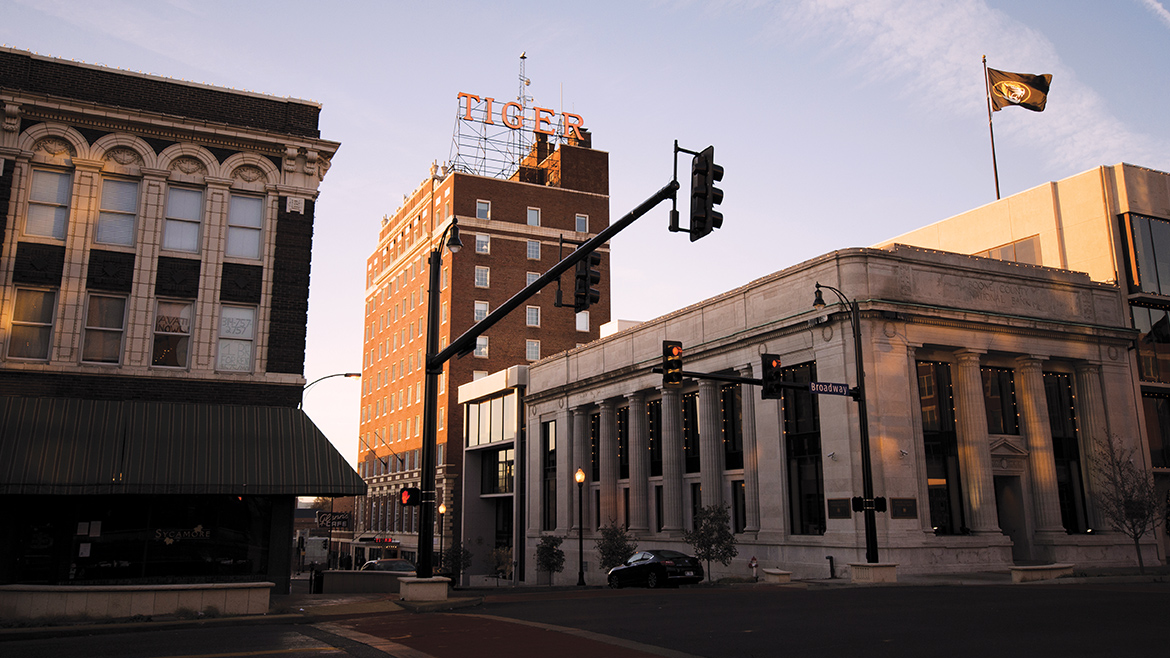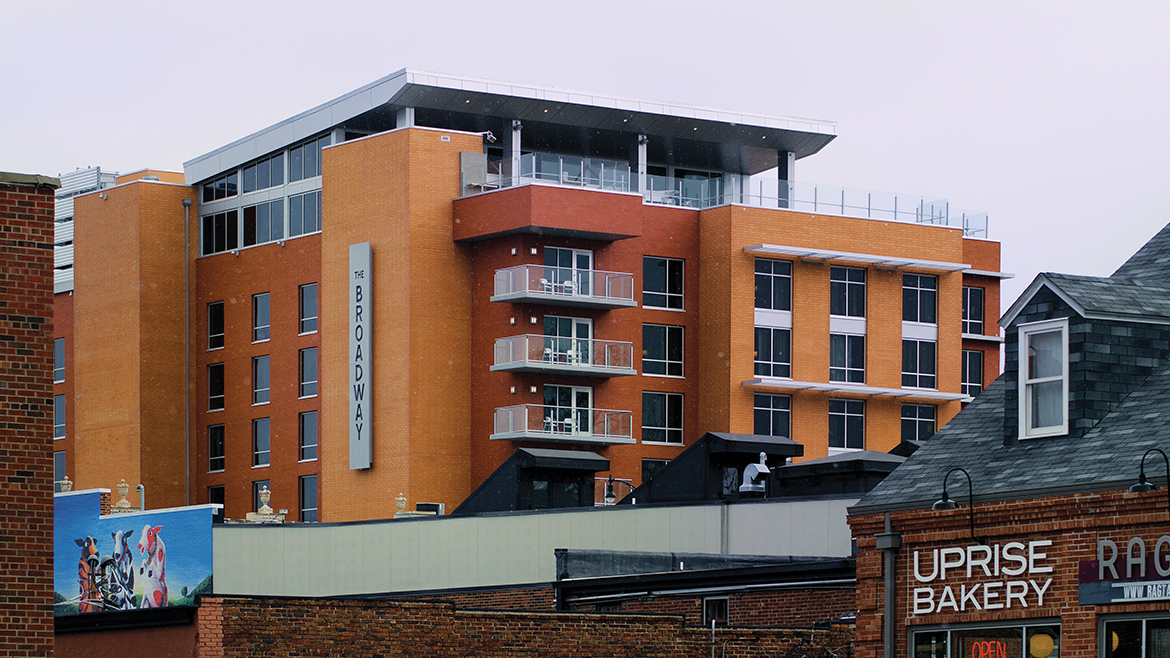TIF Tiff

Two hotels brought tax-increment financing to downtown, setting off a complicated debate in Boone County.
The view from The Roof, the bar atop The Broadway hotel, is probably the best in downtown Columbia. The hotel is on the eastern edge of the central business district, and The Roof’s balcony has glass walls to minimize visual interference. On weekdays, the bar opens around twilight, when downtown is washed in orange before the lights switch on and the sky darkens and the view changes. The city skyline’s defining features come into focus: Jesse Hall on MU’s campus; the short-stack buildings along Ninth Street and Broadway; the church steeple immediately across the street. Above all of these is a bright sign. It says “TIGER” in eight-by-seven-foot letters, glowing in orange neon on the roof of The Tiger Hotel, where the sign has been since 1928.
Fifteen years ago, the view was different. The top of the building at 1111 E. Broadway was three stories shorter, for one thing, and it wasn’t “The Roof” of The Broadway — it was the roof of the Regency, a boxy rectangular building and downtown’s only operating hotel at the time. The Tiger sign was unlit, and the building was being used as a retirement home. Or at least the bottom few floors were. The rest weren’t used for anything.
The agent of change was TIF — tax-increment financing. Between 2009 and 2014, the two sites were redeveloped using a peculiar tax incentive that helped downtown Columbia establish two luxury hotels. But the two TIF projects did more than that.
What’s TIF?

California was the first state to use tax-increment financing, back in the early ’50s, and other states followed over the next five decades (Missouri passed its TIF law in 1982; 48 states currently use TIF). In broad strokes, TIF can be seen as a temporary reallocation of hypothetical property taxes. If a developer enters into a TIF agreement, then the assessed tax rate of that property will be frozen, meaning that the owner of the land will pay no more in property taxes than the current rate. But hopefully, as the development develops, the actual assessed value of the parcel will increase. The parcel’s taxing entities continue to gather property tax at the old rate, and any new revenues — however much more the tax would be at the new assessed value of the project — go to the developer, who then uses that revenue to offset development costs. In Columbia, the developer also keeps 50 percent of sales taxes generated by the project. This system continues until either the developer collects the amount preapproved by the city or, in Missouri’s case, 23 years from the start of the development.
Columbia enabled TIF in 2008 and received the first application in 2009. John Ott, Dave Baugher and Al Germond, former owners of The Tiger Hotel, applied for $1.75 million in TIF to help cover the $8.92 million they estimated would be needed to restore The Tiger as a full-service boutique hotel [Disclosure: Dave Baugher and Al Germond own The Business Times Co., which publishes CBT.]
To qualify for a TIF, the project must be deemed worthy by the TIF Commission, a board with representatives from every tax-levying entity in Columbia, then by city council. Several decisions factor into final approval, but two broad factors are the potential benefit of redevelopment — because the city’s goal for a TIF is to increase its tax base — and conditions that would qualify the TIF as a “blighted” or “conservation area” in need of redevelopment.
In an eligibility analysis, provided by a consultant as part of the TIF application, the Tiger’s owners laid out the hotel’s current condition: “evidence of dilapidation; obsolescence; deterioration; excessive vacancy; lack of ventilation, light or sanitary facilities; inadequate utilities; depreciation of physical maintenance; conditions which endanger life or property by fire and other causes … [this condition] constitutes an economic or social liability or menace to the public health, safety, morals, or welfare in its present condition and use.”
The TIF Commission and council approved the application. In 2010, Dave Parmley, of Chesterfield Hotels Inc., applied for TIF. Parmley already owned the Hampton Inn and Suites on the corner of Stadium Blvd. and College Ave. He says he looks for challenging markets with “high barriers to entry,” and downtown Columbia fit. He wanted to buy and redevelop the Regency as an upscale, multi-purpose hotel, but that meant he’d incur the costs of demolition on top of development — a total bill of $17.5 million. He asked for $3.2 million in TIF to help.
“I’m not sure I knew what to expect,” Parmley says. “It was my first TIF project. It was only the second one in the city.”
As part of the agreement, Parmley agreed to sell the city adjacent space for a parking garage, from which The Broadway would lease spaces for guests.
The two TIF projects allowed the city to invest in downtown with minimal financial risk — if both developments went bust, the city wouldn’t stand to lose any money because the TIF wouldn’t start collecting until the development generated an increase in assessed value. In the best-case scenario, the TIFs would catalyze the surrounding areas and start making the city extra tax money even before the TIF had finished paying out to the developer.
So, in the course of three years in the middle of a recession, TIF had helped secure two massive development projects in the heart of the city, both poised to change the nature of hospitality and tourism.
The Pot of Gold
Finding financing for The Tiger proved to be difficult; Tiger Columns LLC, the group owned by Ott, Baugher and Germond, twice secured financing deadline extensions from the city. In 2011, they sold the hotel to Glyn Laverick, a young developer and concert promoter from England who had mostly worked in Canada, where he’d restored historic music theaters. Under the agreement, Tiger Columns would provide some financing while Laverick found the rest and oversaw the renovations.

The change in ownership drew media attention. Two local TV stations ran investigative pieces about Laverick’s business history, calling into question the future of the TIF project. Laverick didn’t respond to interview requests for this story, but in a 2011 interview with CBT he said: “TIF is a complex and powerful tool for cities to use, but they can put in as much protection as they want. In Columbia’s case, the city has no risk whatsoever in this project. If the project isn’t completed, the city will pay out no money. … Sharing these new revenues means that from day one of operations, the city will have increased its sales tax.”
Around the same time, there was a backlash against TIF happening in California, the same place it had been born some 60 years before. The state was languishing in a steep budget crisis, and TIF-funded redevelopment — where potential tax money was flowing to someone besides the cash-strapped government — became politically toxic. In a 2014 article in The Planning Report titled “The Demise of TIF-Funded Redevelopment in California,” George Lefcoe and Charles Swinson, professors of law and accounting respectively, wrote: “The traditional rationale for TIF is that schools, counties and special districts would not lose any property tax revenue … In time, a pot of gold awaits the other taxing entities at the end of the redevelopment rainbow when all agency debts are repaid. At that point, the other taxing entities start to receive the tax increment bonanza that redevelopment made possible. These rationales are seriously flawed.”
The article goes on to say that unchecked TIF development doesn’t generally pay off in increased taxes the way that it’s supposed to; additionally, it doesn’t allow for any increases in property tax revenue that would have occurred naturally, and it encourages investment in some cites to the disadvantage of others. The same thinking has occurred with TIFs in Missouri, particularly in the suburbs of St. Louis.
Laverick opened The Tiger Hotel, complete with bar, restaurant, event space and cupcake shop, in 2012. Parmley opened The Broadway in 2014. The TIF money began flowing. By that point, downtown Columbia couldn’t keep development away — high-rise student housing complexes were going up, new retail was coming in and downtown was becoming a tourist draw, particularly for event and football weekends. The city began promoting the North Village Arts District, the area immediately north of The Broadway, as a revitalized cultural gem.
“TIF has been, in other communities and this community, the economic driver,” says Tony St. Romaine, deputy city manager. “It’s a great benefit.”
St. Romaine helped bring TIFs into Columbia in 2008, and he was pleased when Tiger Columns was the first application; he says the hotel was “not in blight, but headed that direction.” To prepare for TIF in Columbia, St. Romaine says city officials studied its use in other municipalities around Missouri.
“It’s not a handout to developers, and everybody thinks it is,” he says, “and it’s not an additional tax to pay.”

Besides the hotels, the city has approved only one other TIF project — for a student housing development — but the developers took the project in a different direction, and TIF was never used.
In 2014, some city officials, including St. Romaine, City Manager Mike Matthes and Mayor Bob McDavid, tried to establish a TIF district, which would encompass all of downtown, to finance infrastructure repairs. Boone County came out in opposition, citing many of the same reasons that TIF had been shut down in California. Three days before the city council vote (which rejected the TIF district) Boone County Counselor C.J. Dykhouse filed a lawsuit, saying the city had violated TIF law and therefore had no right to use it.
Waiting for TIF
“No matter how much people complain about TIF and complain about growth, the one thing that we’ve always had is a vital downtown,” St. Romaine says. He says the hotel projects have indeed had a catalytic effect on downtown, which includes job creation and the “much needed” parking garage near The Broadway. The assessed values of both hotel parcels have increased: The Broadway’s assessed value went from $251,904 in 2010 to $2,656,000 in 2015, and The Tiger’s went from $322,700 to $1,366,399 during the same period. Downtown is no doubt more economically productive than it was before the hotels were redeveloped, and there are now far more hotel rooms to keep out-of-town guests in The District. But the catalytic effect of the TIFs is hard to isolate — how much of downtown’s growth is due to the hotels and how much is due to other things, like student housing?
Brian McCollum, Boone County collector, is still unsure about the net effect of TIFs in Columbia and whether that net is positive or negative. “These things can go on for 23 years,” he says. “I’m not sure, until I saw the numbers, how many dollars actually get redirected and how much, in 23 years, that assessment changes normally.”

McCollum provided the numbers for The Tiger in 2013 and The Broadway in 2014: between the two, $403,588.47 was redirected to TIF. McCollum said that sales tax revenue would be a good indicator of catalytic TIF impact, but that can be hard to sort as well. In an email, County Assessor Tom Schauwecker wrote: “There is no empirical evidence to support the theory that a TIF has had a positive impact on surrounding properties in downtown Columbia. Proximity to the University of Missouri campus and unprecedented growth in student enrollment has enhanced the demand for property downtown.”
In December, the County won the lawsuit against the city. Judge Gary Oxenhandler ruled that Columbia had violated reporting procedures required for TIFs; as of mid-February, Columbia is banned from creating new TIF projects until 2020. The city appealed the ruling to the Missouri Court of Appeals’ Western District.
Almost concurrently with the lawsuit decision, the hotel TIFs suffered a setback. Following a request from the TIF Commission, the city’s finance department discovered that the two TIFs had been receiving too much sales tax money, due to a legal misinterpretation. The TIFs had been receiving sales tax revenue on hotel room stays, which are exempt under state law (Lynn Cannon, the city’s assistant finance director, characterized the state statute as “somewhat vague”). The taxing entities will reclaim $104,509 from the Tiger TIF and $91,789 from the Regency TIF.
The refund is bad news for all parties. The developers will be paid back slower, which means the tax rates will stay frozen for longer. Parmley says that he was disappointed — but not particularly surprised — by the misinterpretation and its “significant” financial effect on the TIF. He’s unruffled by the city-county dispute, at least in its relation to the two hotel projects. “It appears that the technicality the city failed to report was some annual requirement,” he says. “It seemed to me that it didn’t have much to do with the two TIF projects as much as [the city and county] trying to negotiate with each other over past issues.”
St. Romaine says that the public debate comes down to a difference in “the philosophical understanding of what a TIF is.” When asked what the city’s understanding was, he says, “It enables projects to occur that otherwise would not.”
TIF’s future in Columbia is unclear for now. Two of these projects are now embedded and healthy in the downtown economy. Two hotels now help keep more travelers in the economic center of the city. But TIF is complicated.


